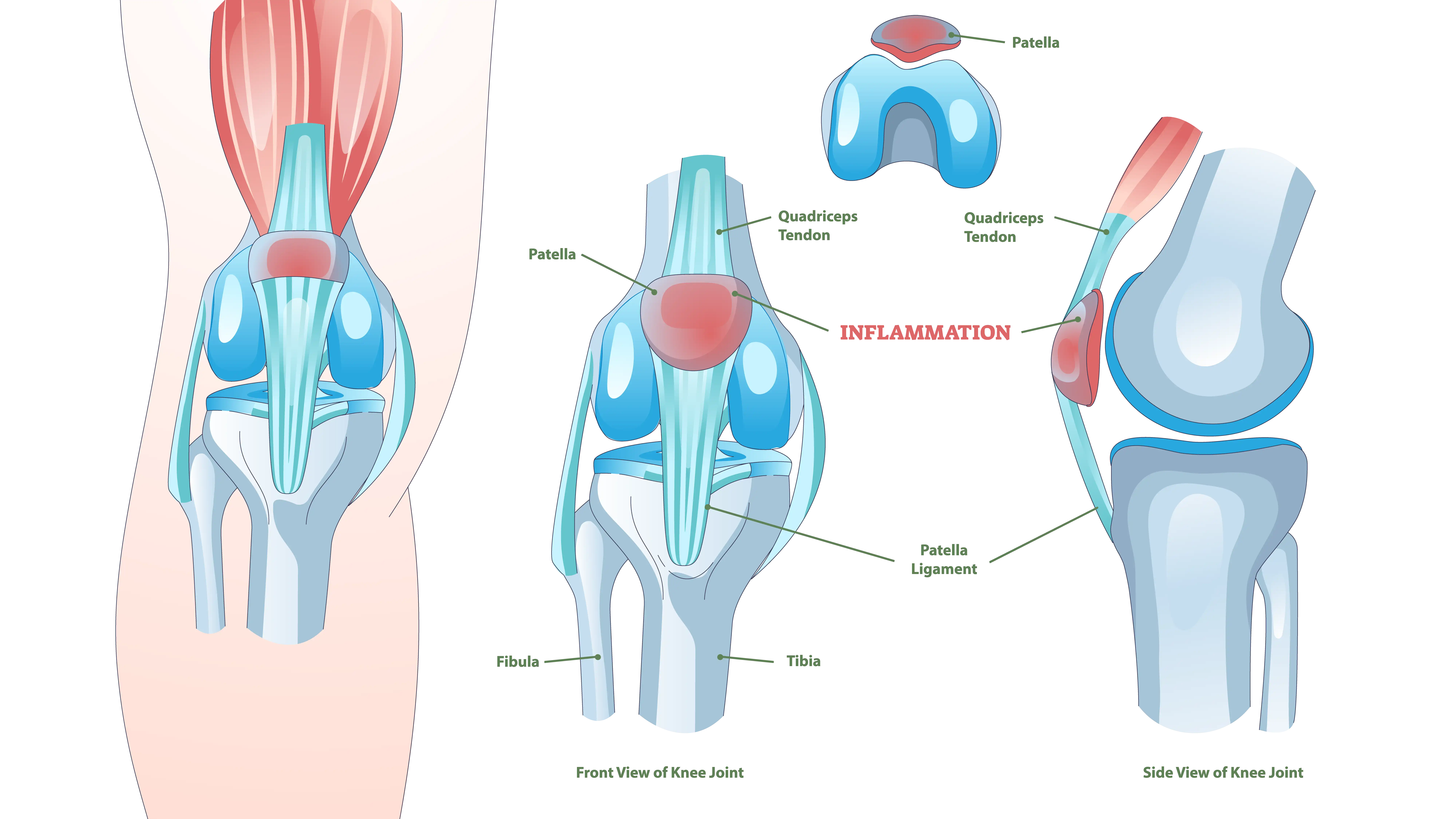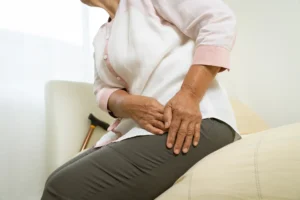Wondering about effective strategies for runner’s knee pain? Runner’s knee, or patellofemoral pain syndrome, causes pain around the kneecap. This post covers what runner’s knee is, how to recognize its symptoms, and effective strategies to manage it.
Key Takeaways
- Runner’s knee, a common condition in active individuals, is characterized by dull pain around the kneecap, often worsening during physical activity.
- Key causes of runner’s knee include overuse, improper alignment of the kneecap, muscle weakness, and previous knee injuries.
- Treatment options range from conservative methods like physical therapy and anti-inflammatory medications to surgery, with early intervention and preventive measures playing an important role in symptom management.
Understanding Runner’s Knee
Runner’s knee, medically known as patellofemoral pain syndrome, is a condition affecting the knee joint. It is particularly common among teenagers and physically active individuals. Studies show that 20 to 45 percent of adolescents experience runner’s knee at some point in their lives. The pain associated with runner’s knee can vary significantly, lasting anywhere from a few weeks to several years.

The hallmark of runner’s knee is a dull, aching pain that typically manifests in the front of the knee (around the kneecap). This pain often intensifies during activities that put stress on the knee joint, such as running, hiking, or even walking up and down stairs. This discomfort can significantly impact daily mobility.
Now, let’s explore what causes this condition and how to spot the warning signs.
Causes of Runner’s Knee
The primary cause of runner’s knee is often overuse, particularly from activities such as jogging, hiking, and cycling on hilly terrain. Sudden increases in the duration, intensity, or frequency of these activities raise the risk of developing knee problems. This explains why athletes who consistently push their physical limits may be especially vulnerable.
Anatomical factors also contribute. Improper kneecap alignment may occur in individuals with bow-leggedness or knock knees. Additionally, a larger-than-normal Q-angle, which is the angle between the hip and the knee, can contribute to this misalignment.
Muscle weaknesses can also play a role in the development of runner’s knee. When the thigh and hip muscles are weak or imbalanced, they may distribute pressure unevenly across the knee joint. Previous injuries, including kneecap dislocations or fractures, further predispose individuals to runner’s knee. Understanding these causes can help you take preventive measures and seek appropriate treatment when necessary.
Recognizing Symptoms
Knowing the symptoms of runner’s knee is key to early intervention and effective treatment. Patients typically experience a dull, aching pain in the front of the knee, near the kneecap. This pain often worsens during activities that stress the knee joint, such as running, walking up or down stairs, and sitting for long periods.
Other common symptoms include knee tenderness and sensations like crackling, crunching, or creaking sounds originating from the knee.
For many individuals, these symptoms can be a constant reminder of the condition, affecting their daily activities and overall quality of life.
Diagnosis Process
Diagnosing runner’s knee typically begins with a thorough review of the patient’s history. Your doctor will ask about your symptoms, activity levels, and any previous injuries to understand the potential causes of your knee pain. Following this, a physical examination is conducted to check for knee tenderness, mild swelling, and the alignment of the kneecap. Your doctor may apply gentle pressure to the extended kneecap to test for pain.
In some cases, imaging tests like MRIs may be necessary to rule out other conditions, such as a torn meniscus or osteoarthritis. Special questionnaires might also be utilized to gather more accurate descriptions of your symptoms.
As you prepare for your consultation, come prepared to discuss your symptoms in detail, including what activities aggravate or relieve your discomfort.
Treatment Options
Treating runner’s knee involves options ranging from conservative methods to surgical interventions, all aimed at reducing pain and promoting healing.
A customized physical therapy program is often the cornerstone of treatment, focusing on strengthening the muscles around the knee and optimizing joint function. Let’s explore these treatment options in more detail.
Conservative Treatments
Conservative treatments are often the first line of defense against runner’s knee. Pain-relieving and anti-inflammatory gels or creams containing ibuprofen or diclofenac, applied to the affected area, may be recommended. These creams should be applied two to four times a day for effective relief. Non-steroidal anti-inflammatory drugs are also commonly prescribed to alleviate pain and swelling.
The R.I.C.E. protocol (rest, ice, compression, elevation), along with taking a break from activities that exacerbate the pain, can help reduce inflammation and provide relief. These simple yet effective measures can make a significant difference in managing the symptoms of runner’s knee.
Another treatment that may be recommended is platelet-rich plasma (PRP) injection knee therapy. This approach directly delivers your own platelets to the injured area, which can help to reduce inflammation and promote tissue repair.
Physical Therapy
Sports medicine specialists and orthopedic surgeons often recommend physical therapy as a targeted approach to managing runner’s knee. A physical therapist will design tailored rehabilitation programs that include exercises targeting the thigh and hip muscles to improve knee joint function. These strengthening exercises can help correct muscle imbalances and enhance the stability of the knee joint.
In addition to strengthening exercises, physical therapy may involve other techniques such as rest, ice application, and stretching to reduce pain and improve flexibility.
Orthotics and Braces
Orthopedic surgeons and physical therapists sometimes include orthotics and braces in treatment plans. Biomechanical support plays a helpful role in treatment, providing additional stabilization and improving knee alignment. Orthotics and braces can help alleviate pressure on the knee and reduce discomfort during physical activity.
Surgical Interventions
Surgery may be considered when conservative treatments fail to provide symptom relief over time. An experienced orthopedic surgeon will recommend a procedure depending on the specific anatomical contributors and severity of the condition. However, surgery is usually the last resort and is generally only recommended when other treatment options have been exhausted.
Preventive Measures
Prevention plays an essential role in reducing the risk of runner’s knee, especially for active individuals. Implementing proper warm-up routines with dynamic stretches prepares the muscles and joints for activity. Incorporating cross-training activities such as swimming or cycling, along with rest days, allows for adequate recovery and helps prevent overuse.
A comprehensive exercise program that emphasizes flexibility and strength can significantly aid in preventing runner’s knee. Many athletes benefit from professional gait analysis to identify and correct issues in running form that may lead to injuries. Proper footwear selection further supports knee health.
By taking these preventive measures, you can reduce your risk of developing runner’s knee and maintain your active lifestyle.
Living with Runner’s Knee
Managing runner’s knee requires a balanced approach that combines patience with proactive care. Incorporating low-impact alternatives like cycling or swimming into your fitness routine can help keep your fitness levels up while recovering from knee pain. The recovery timeline varies between individuals, and pushing too hard too soon often prolongs healing, so patience is necessary for proper recovery.
Successful long-term management involves learning to recognize early warning signs and adjusting activities accordingly. Many patients find that balancing rest with gentle exercise can manage symptoms, enabling an active lifestyle despite runner’s knee challenges.
When to Consult a Doctor
Seek medical advice if knee pain persists for more than a few days or if movement becomes increasingly difficult. Patients should also seek professional care if symptoms worsen despite initial self-care measures like rest and ice application.
For those who have followed a treatment regimen without improvement, a consultation with an orthopedic surgeon may be warranted to discuss advanced treatment options. This is especially important if conservative treatment fails to provide relief over a prolonged period.
By consulting a healthcare professional, you can receive a proper diagnosis and explore advanced treatment options to manage your knee pain effectively.
Summary
In summary, runner’s knee, clinically known as patellofemoral pain syndrome, represents a common but generally manageable orthopedic condition. Early diagnosis and appropriate treatment can help alleviate pain and improve knee function, allowing you to maintain an active lifestyle. From conservative treatments and physical therapy to orthotics and surgical interventions, there are various strategies available to manage runner’s knee.
By taking preventive measures and seeking medical advice when necessary, you can reduce the risk of developing runner’s knee and ensure a swift recovery if you do experience knee pain. Remember, being patient with the healing process is key to overcoming the challenges of runner’s knee.
Frequently Asked Questions
What is runner’s knee?
Runner’s knee, clinically known as patellofemoral pain syndrome, is marked by pain around the kneecap, typically resulting from overuse or misalignment of the knee joint. Proper identification of contributing factors is essential for effective long-term management.
What are the symptoms of runner’s knee?
Patients typically experience a dull, aching pain at the front of the knee, often accompanied by tenderness and crunching or crackling sensations during movement. These signs indicate a need for rest and evaluation to prevent further injury.
How is runner’s knee diagnosed?
Runner’s knee is diagnosed through a medical history review, a physical examination, and potentially imaging tests to exclude other issues. This approach helps differentiate runner’s knee from other potential knee conditions while identifying contributing factors.
What are the treatment options for runner’s knee?
Effective treatment options for runner’s knee include conservative methods such as pain-relieving creams, anti-inflammatory medications, physical therapy, and the use of orthotics or braces. In more severe cases, surgical interventions may be considered.
How can I prevent runner’s knee?
Prevention strategies emphasize warm-up stretches, proper training progression, and incorporating cross-training and rest days. Individuals may also benefit from a professional assessment of their running form.




